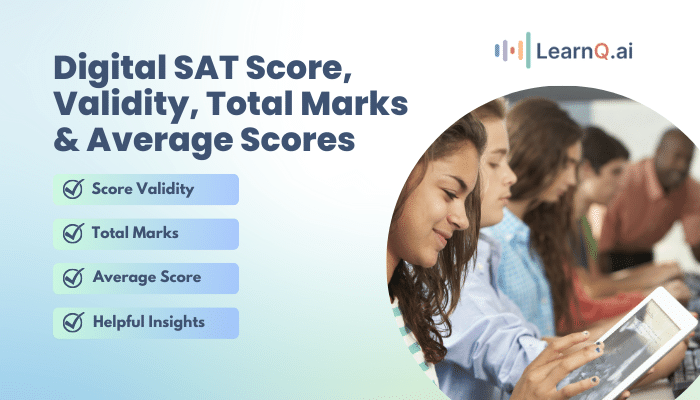Just when you thought standardized testing couldn’t get any more futuristic, the SAT went digital and gave us all a little taste of 21st-century academia. So, buckle up and get ready to navigate the brave new world of Digital SAT scores, validity, total marks, and those all-important average scores.
It’s time to digitize your path to college success with a guide that’s as engaging as scrolling through your favorite social media feed—minus the cat videos, of course.
Introduction to Digital SAT Scores
The landscape of college admissions testing has shifted! In 2024, the SAT transitioned to a fully digital format, offering a streamlined testing experience for students. Let’s delve into the key aspects of Digital SAT scores, including understanding the Digital SAT Average Score.
Overview of the digital SAT and its introduction in 2024
The College Board, the organization that administers the SAT, introduced the digital SAT in the Spring of 2024. This marked a significant shift from the traditional paper-and-pencil test. Students can now take the SAT on a computer or tablet, including their own devices in certain cases. The digital format boasts several advantages, including:
- Increased efficiency: The digital test takes less time to complete compared to the traditional SAT (2 hours vs. 3 hours).
- Enhanced accessibility: Features like text-to-speech and on-screen calculators can benefit students with specific needs.
- Quicker score reporting: Students can receive their digital SAT scores within days instead of weeks.
A brief explanation of adaptive testing and its impact on scoring
A defining characteristic of the Digital SAT is its use of adaptive testing. This means the difficulty of the questions you encounter adjusts based on your performance. Here’s how it works:
- You’ll start with a mix of easy, medium, and hard questions in each section (Reading & Writing, Math).
- If you answer correctly, the difficulty of subsequent questions will increase. Conversely, if you struggle, the questions will become easier.
- This personalized approach ensures the test accurately measures your abilities and provides a score that reflects your true potential.
However, adaptive testing also impacts scoring:
- Since the difficulty varies, raw scores (number of correct answers) might not directly translate to traditional SAT scoring.
- The College Board utilizes a sophisticated algorithm to convert your raw score on each section into a scaled score ranging from 400 to 1600.
Importance of digital SAT scores in college admissions
While the format has changed, the importance of your SAT score in college admissions remains. Here’s why your digital SAT score still matters:
- Standardized benchmark: Colleges use your score as a common metric to compare applicants from diverse academic backgrounds.
- Indicator of college readiness: A strong score demonstrates your critical thinking, reading comprehension, and problem-solving skills, all essential for success in college.
- Scholarship opportunities: Many scholarships consider your SAT score for eligibility or award amounts.
Although the digital SAT introduces a new testing environment, the value your score holds in college admissions persists.
Understanding Digital SAT Scoring, Including Digital SAT Average Score
The Digital SAT may be a new format, but the core principles of scoring remain familiar. This section breaks down how your digital SAT score is calculated, including exploring the concept of Digital SAT Average Score. Here, we’ll discuss what the average score means and how it can be a benchmark for your own test prep goals.
Score Scale from 400-1600 Explained
Just like the traditional SAT, the Digital SAT uses a scaled score system ranging from 400 to 1600. This score represents your overall performance on the test. Each section (Reading & Writing, Math) is also scored on a scale of 200-800. Your total score is the sum of these two section scores.
Similarities in Scoring Method with the Traditional SAT
While the digital format introduces adaptive testing, there are still similarities to the traditional SAT scoring method:
- Raw Score Calculation: Similar to the traditional SAT, the Digital SAT keeps track of the number of questions you answer correctly in each section. This initial tally is your raw score. There is no penalty for incorrect answers, so guess if you are unsure. By doing this, you increase your odds of getting it correct by 25%!
| Sections in DSAT | No. of Questions in DSAT | What’s the Raw Score Range |
| Reading and Writing (R/W) | 54 | 0-54 |
| Mathematics | 44 | 0-44 |
- Conversion to Scaled Score: Both formats utilize a statistical process to convert your raw score into a scaled score (200-800 per section, 400-1600 total). This conversion accounts for the overall difficulty of the test you took and ensures scores are comparable across different test administrations.
Scoring Structures for Digital SATs
The Digital SAT is scored on a range of 200 to 800 for each section. Let’s see the process of converting the raw scores from the RW and Math parts into scaled scores.
- Maths
- Reading and Writing Section
Key Differences in Digital SAT Scoring, Especially in Reading and Math Sections
The introduction of adaptive testing brings some key differences to Digital SAT scoring:
- Impact of Difficulty: In the traditional SAT, all students received the same set of questions. With adaptive testing, the difficulty of the questions you encounter varies. This means a raw score of, say, 20 correct answers might not hold the same weight for everyone depending on the difficulty level of the questions answered correctly.
- Focus on Ability: The Digital SAT scoring algorithm goes beyond the raw number of correct answers. It considers your response patterns, such as answering difficult questions correctly, to provide a more nuanced picture of your abilities.
Explanation of How Answering Difficult Questions Affects Scoring
Since the Digital SAT adapts to your performance, answering difficult questions strategically impacts your score:
- Correctly Answering Hard Questions: Tackling challenging questions demonstrates a deeper understanding of the subject matter. The algorithm recognizes this and awards you more points for these answers, potentially boosting your scaled score.
- Skipping or Answering Incorrectly on Hard Questions: While it’s okay to skip particularly difficult questions, consistently doing so might limit your opportunity to showcase your abilities on the more challenging material.
The key takeaway is to attempt all questions to the best of your ability, with a focus on answering the harder ones correctly to maximize your score.
Want to practice hard questions? Try LearnQ.ai’s mock test!
Digital SAT Score Comparison
The Digital SAT introduces a new testing environment, but how do scores compare to the traditional format and other standardized tests? This section sheds light on these comparisons.
College Board’s Statement on Score Equivalence Between Digital and Traditional SAT Formats
The College Board, the organization that administers the SAT, assures students that scores from the digital and traditional formats are equivalent. They have conducted extensive studies to ensure scores from both formats are comparable and reflect similar levels of college readiness.
Here’s what this means for you:
- Colleges will evaluate your digital SAT score using the same scoring benchmarks they used for the traditional SAT.
- A score of 1200 on the digital SAT should hold the same weight as 1200 on the traditional SAT in the eyes of admissions officers (assuming similar score distributions across both formats).
Essentially, the College Board is vouching for the consistency of scoring across formats.
Comparing Digital SAT Scores to Other Standardized Tests Like the ACT
While the SAT is a widely accepted college admissions test, some students choose the ACT (American College Testing) as an alternative. Here’s how digital SAT scores compare:
- Different Scoring Systems: The ACT uses a score range of 1-36, while the digital SAT remains at 400-1600. Direct score comparisons aren’t entirely straightforward.
- Focus and Skills Assessed: There’s some overlap in the skills assessed by both tests (reading comprehension, math, writing), but they might have slightly different emphases.
It’s important to research the specific requirements of colleges you’re interested in. Some colleges might be test-optional, while others might have a preference for the SAT or ACT.
The key takeaway is that colleges will evaluate your score within the context of the test you choose (SAT or ACT). A strong score on either test can demonstrate your college readiness.
What Counts as a Good Digital SAT Score?
Scoring well on the Digital SAT can significantly strengthen your college application. But what exactly constitutes a “good” score? This section explores how to define and achieve a competitive score while considering its role in the broader college admissions picture.
Definition and Significance of a ‘Good Score’
There’s no universal answer to “good” when it comes to digital SAT scores. It depends on several factors, including:
- College selectivity: Highly competitive colleges might expect higher scores (e.g., 1400+), while less competitive schools might have lower score expectations (e.g., 1000-1200).
- Intended major: Some majors, like engineering or science, might place a higher emphasis on math scores.
However, a good score generally translates to one that:
- Meets or exceeds the average score for your target colleges.
- Positions you competitively within the applicant pool for those colleges.
- Reflects your academic potential and preparedness for college-level work.
A good score is a stepping stone, not a sole factor, in securing college admission.
Impact of Score Alongside Other College Admission Criteria
While a strong digital SAT score is a valuable asset, it’s just one piece of the college admissions puzzle. Here are other factors considered by colleges:
- GPA and academic rigor of your coursework: Your high school GPA demonstrates your academic performance over time. Colleges also value the difficulty level of the courses you take.
- Extracurricular activities and achievements: Admissions officers look for well-rounded individuals. Your involvement in sports, clubs, volunteer work, or other activities showcases your leadership, teamwork, and passions.
- Letters of recommendation: Strong recommendations from teachers or counselors can provide valuable insights into your character, work ethic, and potential.
- Essays and applications materials: Your essays allow you to tell your story and highlight your unique voice, goals, and motivations.
The key takeaway is to focus on building a well-rounded application that showcases your strengths across various aspects. A good digital SAT score can complement your application, but it shouldn’t be the sole focus of your college preparation strategy.
College Admissions and Digital SAT Scores
The Digital SAT score is a significant factor considered by colleges during the admissions process. Let’s delve into how admissions offices utilize these scores and understand their role within the broader admissions landscape.
Use of Digital SAT Scores by College Admissions Offices
Colleges see your digital SAT score as a standardized metric that helps them compare applicants from diverse academic backgrounds. Here’s how they typically use your score:
- Assessing College Readiness: A strong score suggests you possess the critical thinking, reading comprehension, and problem-solving skills necessary to succeed in college-level coursework.
- Benchmarking Applicants: Colleges often have average score ranges for admitted students. Your score helps them gauge how you compare to other applicants in terms of academic preparedness.
- Scholarship Eligibility: Many scholarships consider your SAT score for eligibility or award amounts. A high score can unlock scholarship opportunities to help finance your education.
While the score is important, admissions officers are looking beyond just a number.
The Multifaceted Nature of College Admissions and the Role of Scores Within It
College admissions are a holistic process that considers various aspects of an applicant. Here’s why your SAT score is just one piece of the puzzle:
- Focus on Well-Rounded Individuals: Admissions officers want to see well-developed individuals with diverse interests and experiences. Your extracurricular activities, essays, and letters of recommendation paint a more complete picture of who you are.
- Demonstrating Potential Beyond Test Scores: A high GPA and a strong course load throughout high school indicate your commitment to academics.
- Considering Diverse Backgrounds: Standardized tests can sometimes be biased. Colleges might employ additional factors like interviews or essays to evaluate applicants from disadvantaged backgrounds who may not have had equal opportunities to prepare for the SAT.
The key takeaway is that your digital SAT score is a valuable data point, but it’s evaluated alongside your entire application to create a comprehensive picture of your potential as a student.
Improving Your Digital SAT Score
Conquering the Digital SAT requires a solid strategy. This section equips you with effective test-taking techniques specifically tailored for the digital format, along with tips for maximizing your score on a retake.
Strategies for Test-Taking Specific to the Digital SAT
The digital environment introduces some unique elements to consider:
- Master the Interface: Familiarize yourself with the digital testing platform beforehand. Practice navigating the interface, using the on-screen tools (calculator, highlighter), and flagging questions for review.
- Time Management: The Digital SAT is shorter than the traditional format. Develop a time management strategy to ensure you dedicate sufficient time to each section and question. Practice tests can help you refine your pacing.
- Embrace Adaptive Testing: Don’t be discouraged if the initial questions seem difficult. The test adapts to your performance, so focus on answering each question to the best of your ability. Getting harder questions correct can significantly boost your score.
- Utilize Digital Tools: Take advantage of the built-in digital tools like the on-screen calculator and the highlighting feature to mark important passages or answer choices.
Remember, staying calm, focused, and adapting to the digital format are key to performing well.
Seeking for a DSAT course that can help you strategically prepare for your exams? LearnQ.ai got you!
Tips for Retaking the Digital SAT and Improving Scores
If you plan to retake the Digital SAT, here are some strategies to maximize your score improvement:
- Analyze Your Score Report: The score report provides valuable insights into your strengths and weaknesses. Identify areas where you can improve and focus your preparation efforts accordingly.
- Targeted Practice: Utilize practice tests and prep materials that address your specific weaknesses. Focus on question types you struggled with and practice strategies to overcome them.
- Time Yourself: Simulate the real test environment by taking timed practice tests under pressure. This helps you refine your pacing and build stamina for the actual test day.
- Seek Professional Help: Consider enrolling in a test prep course or working with a tutor who can provide personalized guidance and feedback on your test-taking skills.
By diligently analyzing your performance and strategically preparing, you can significantly improve your score on a retake.
Want to retake your exams? Searching for help? Leverage LearnQ.ai!
Accessing and Interpreting Your Digital SAT Scores
Acing the Digital SAT is just the first step. Now it’s time to access and understand your score! This section guides you through the process and helps you interpret your results.
Guide on How to Access Scores Online
The College Board provides a convenient online portal to access your digital SAT scores. Here’s how:
- Head to the College Board website: Go to website
- Sign in to your College Board account: Create an account if you haven’t already. Use the same credentials you used to register for the SAT.
- Navigate to Scores: Look for a section or link labeled “Scores” or “My SAT Scores.”
- Select the Digital SAT date: Choose the specific administration you want to view scores for.
- View your score report: The platform will display your total score, section scores (Reading & Writing, Math), and percentile rankings.
The entire process is usually quick and straightforward.
Interpreting Your Digital SAT Scores and Understanding Score Placement
Your score report provides a wealth of information, but deciphering it can be overwhelming. Here’s a breakdown of key elements:
- Total Score (400-1600): This is the sum of your scores in Reading & Writing (200-800) and Math (200-800).
- Percentile Rankings: This indicates how your score compares to other test-takers. For instance, a 75th percentile score means you performed better than 75% of test-takers.
- Score Distributions: The report might also include visualizations of how scores are distributed across different score ranges.
Remember, a higher score generally translates to a stronger performance and a higher percentile ranking.
Importance of Score Reports for College Admissions and Scholarships
Your digital SAT score report is a crucial document for college admissions and scholarship applications:
- College Applications: Most colleges require you to submit your official score report electronically through the College Board.
- Scholarship Eligibility: Many scholarships consider your SAT score for eligibility or award amounts. Your score report verifies your score.
Make sure to submit your score report to all colleges and scholarship programs you’re applying to by their deadlines.
Understand your score report and its implications for your college and scholarship applications. By effectively interpreting your results, you can strategically utilize them to bolster your college aspirations.
Score Reporting and College Applications
Your digital SAT score is a vital piece of your college application puzzle. This section navigates the process of submitting your scores to colleges and universities while ensuring a smooth application journey.
Process of Submitting Digital SAT Scores to Colleges and Universities
The College Board streamlines score reporting for the Digital SAT. Here’s how to submit your scores to colleges:
- Access Your Score Report: Log in to your College Board account and navigate to the score reporting section (as explained in the previous section).
- Select Colleges: Choose the colleges you want to receive your score report. You can search for colleges by name or code.
- Review and Submit: Double-check your selections and ensure all desired colleges are listed. Then, submit the request electronically.
The College Board handles the rest, securely sending your scores to the colleges you designate.
Important points to remember:
- There might be fees associated with score reports. Check the College Board website for current pricing information.
- Deadlines are crucial. Submit your score reports well in advance of college application deadlines to avoid any last-minute hiccups.
Want to learn all about the pricing details? Click here!
Managing College Application Submissions Alongside Your SAT Scores
Juggling college applications and score reporting requires organization and planning. Here are some tips for seamless coordination:
- Research College Deadlines: Gather information on application deadlines for all colleges you’re considering.
- Plan Your Test Date: Ideally, schedule your Digital SAT well before application deadlines to allow ample time for score reporting.
- Consider Score Reporting Options: The College Board offers various score report options, including rush reporting for an additional fee. Choose the option that aligns with your deadlines.
- Track Your Applications and Scores: Maintain a system to track application deadlines and score reporting requests. This ensures you stay on top of important dates and avoid any missed deadlines.
By planning strategically and managing deadlines effectively, you can ensure your digital SAT scores arrive at colleges alongside your complete applications.
Conclusion: Mastering the Digital SAT and Reaching Your College Dreams
The Digital SAT offers a streamlined testing experience with scoring that remains consistent with the traditional format. By understanding the score components, validity, and general range of Digital SAT average scores, you can effectively strategize your test preparation.
The Digital SAT offers a streamlined testing experience with scoring that remains consistent with the traditional format. By understanding the score components, validity, and average score ranges, you can effectively strategize your test preparation.
However, navigating the path to a competitive score requires a personalized approach. This is where LearnQ.ai steps in as your ultimate digital SAT companion.
LearnQ.ai’s innovative platform utilizes cutting-edge AI technology to create a dynamic, gamified learning experience tailored to your strengths and weaknesses. Our platform continuously analyzes your performance, constructing real-time knowledge graphs to personalize bite-sized learning modules. This ensures you focus on the areas that matter most, maximizing your potential for a stellar score.
Don’t settle for generic test prep solutions. Visit LearnQ.ai today and explore our comprehensive suite of products, including interactive practice tests, personalized feedback from our AI tutor “Mia,” and data-driven insights to track your progress. With LearnQ.ai by your side, you can conquer the Digital SAT and confidently take that next step toward your college aspirations!











